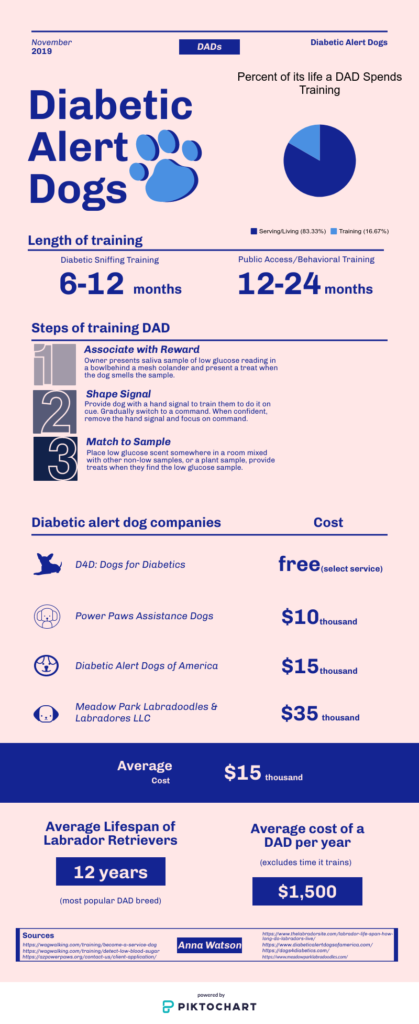
I want a dog.
I don’t want any dog – I want a dog that can save my life. This past August was my 10th anniversary of being a diabetic. The anniversary of the three days spent in the hospital, learning how to be a diabetic. For 10 years I have pricked my fingers numerous times per day to the point where I have itty bitty holes at the tips. It’s imperative that I try to keep my blood sugar balanced. This means not allowing it to go too high (above 150) or too low (below 80) for an extended period.
Low blood sugar has a more immediate effect – causing me to pass out. The lowest I have ever reached is 22. But his past spring, my sugar stayed above 300 for over a day before spiking to 600 and being admitted to the ER. It was the absolute worst I had felt in my entire life and it was all my fault.
A few days prior to the incident, I was loading up on carbs: pizza, Chick-fil-a, sweet tea and a smoothie. The cannula (like a small IV) in my pump had come out of my body and I wasn’t getting any insulin (what counteracts my sugars). Pumps are designed to help in situations like this – they try to prevent dramatic lows and highs from occurring.
Diabetes is manageable, but it can kill. Diabetes was the seventh leading cause of death in 2016 (6.1 million per year). The long-term effects of diabetes or bad blood sugar levels are horrifying. Diabetes is a major cause of kidney failure, stroke, heart attacks, blindness and the loss of lower limbs.
Realizing the side effects that await me are scary. Realizing that I’m going to be responsible for passing on this disease to my children makes me feel guilty already. It doesn’t help that my siblings have a higher chance of getting it just because I have it.

I’m glad I have the pump that can help take care of me and people who support me and help me try to take care of myself – but what about when I live on my own? When I had to spend the night in the hospital last semester, my nurse told me about a diabetic she knew that lost both of her legs and died alone in her apartment because she couldn’t take care of herself.
That’s what diabetic alert dogs are for, they’re specific service dogs that are trained to smell low and high blood sugar levels. There are countless testimonies online about how they have saved lives by alerting their owners about their low blood sugars.
Diabetic alert dogs are incredibly expensive, ranging from $15,000 to $35,000. The only affordable company is D4D: Dogs for Diabetics, which is solely donation-based. This allows them to service diabetics free of charge, however, they only service California, Oregon and Washington.
Discouraged by companies taking advantage of my disability, I searched the internet for training tips on how I could train my own diabetic alert dog. The training for it is not too complicated either, which makes me wonder why the pre-trained alert dogs are so incredibly expensive. I would already be in the process of training my own alert dog. However, Piedmont won’t allow me to do so.
Since I’m an athlete, it is required of me to live on campus. And non-service animals aren’t allowed on campus. The only solution is to do it off-campus in between semesters – but that’s not nearly enough time, it takes between six to 24 months to fully train an alert dog.
Once I graduate, I will have to train a dog while living by myself as well as sustain another job for income. Even though it feels like no one is on my side, these frustrations and obstacles have fueled my dreams of owning a dog training business in the future that specializes in diabetic alert dogs and provides them at low to no cost. I don’t want to live a painful life, and I want to ensure other diabetics don’t either.








